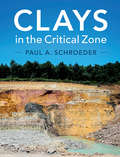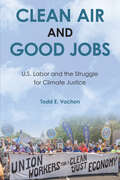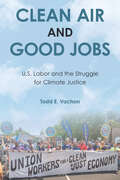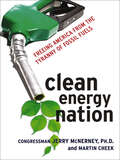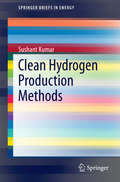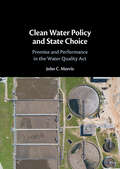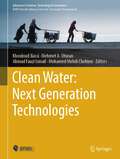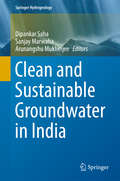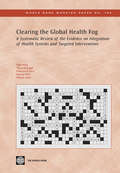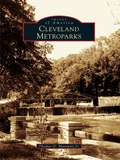- Table View
- List View
Clay Minerals: Their Antimicrobial and Antitoxic Applications
by Bhaskar Ghosh Dola ChakrabortyThis book provides a comprehensive description of the application of clay minerals as disinfectants and the ingredients of medicines. While the presently available literature highlights one or two aspects of medicinal clays, a comprehensive text on all their major pharmaceutical applications is lacking. This book endeavors to fill up this lacuna. It further elucidates the properties of clay minerals that facilitate their application in the protection of human health, and how these properties are related to the chemical compositions and internal structures of selected mineral groups, thus revealing to the students, teachers and researchers the underlying relationship of seemingly different disciplines like mineralogy, material science and medical science. The thought-provoking questions added at the end of each chapter will give the readers a better insight of this subject. The tangible definitions and explanations of all the relevant scientific terms provided in this book, both within the text and in a glossary list at the end, are expected to help the beginners to develop a clear-cut understanding regarding different aspects of the subject and clear any confusion resulting from the ambiguous usage of terms in the existing literature.
Clay: The History and Evolution of Humankind's Relationship with Earth's Most Primal Element
by Suzanne StaubachThe clay beneath our feet is crucial to the computer and space industries, biotechnology, publishing, and a wide range of manufacturing processes. The potter's wheel was the very first machine. With the invention of pottery came cooking and storage vessels, ceramics, the discovery of alcoholic beverages, the oven, clay tablets for the first written communication, irrigation for agriculture, vast trade networks, plumbing, sanitation, and an incredibly durable building material. Much of the Great Wall of China was made of fired clay bricks-a material that can stand for centuries. Now, Suzanne Staubach presents a lively look at how civilization was built on clay-from the first spark plugs to modern semi-conductors, satellite communications to surgical equipment. Clay is a fascinating, colorful look at how, from the primordial ooze to modern miracles, this humblest of substances continues to shape our world in ways limited only by the human imagination.
Clays in the Critical Zone
by Paul A. SchroederClays and clay minerals are the most abundant natural reactive solids on the Earth's surface. This comprehensive review considers clay science in the context of the Critical Zone - the Earth's permeable near-surface layer. Providing information on clays and clay minerals related to geological, biological and material sciences in the Critical Zone, it's well suited for graduate students and researchers interested in clay science, and environmental and soil mineralogy. The book starts with an introduction to clays and clay minerals, their historic background, and a review of how clay science impacts the Critical Zone. Examples and applications demonstrate how clays regulate habitats and determine the availability of other resources. These examples are supported by quantitative field data, including numerical and graphical depictions of clay and clay mineral occurrences. The book concludes by covering Critical Zone clay geochemistry and clay sequences, including the industrial, synthetic medical and extra-terrestrial world of clay science.
Clean Air and Good Jobs: U.S. Labor and the Struggle for Climate Justice
by Todd E. VachonThe labor–climate movement in the U.S. laid the groundwork for the Green New Deal by building a base within labor for supporting climate protection as a vehicle for good jobs. But as we confront the climate crisis and seek environmental justice, a “jobs vs. environment” discourse often pits workers against climate activists. How can we make a “just transition” moving away from fossil fuels, while also compensating for the human cost when jobs are lost or displaced? In his timely book, Clean Air and Good Jobs, Todd Vachon examines the labor–climate movement and demonstrates what can be envisioned and accomplished when climate justice is on labor’s agenda and unions work together with other social movements to formulate bold solutions to the climate crisis. Vachon profiles the workers and union leaders who have been waging a slow, but steadily growing revolution within their unions to make labor as a whole an active and progressive champion for both workers and the environment. Clean Air and Good Jobs examines the “movement within the movement” offering useful solutions to the dual crises of climate and inequality.
Clean Air and Good Jobs: U.S. Labor and the Struggle for Climate Justice
by Todd E. VachonThe labor–climate movement in the U.S. laid the groundwork for the Green New Deal by building a base within labor for supporting climate protection as a vehicle for good jobs. But as we confront the climate crisis and seek environmental justice, a “jobs vs. environment” discourse often pits workers against climate activists. How can we make a “just transition” moving away from fossil fuels, while also compensating for the human cost when jobs are lost or displaced? In his timely book, Clean Air and Good Jobs, Todd Vachon examines the labor–climate movement and demonstrates what can be envisioned and accomplished when climate justice is on labor’s agenda and unions work together with other social movements to formulate bold solutions to the climate crisis. Vachon profiles the workers and union leaders who have been waging a slow, but steadily growing revolution within their unions to make labor as a whole an active and progressive champion for both workers and the environment. Clean Air and Good Jobs examines the “movement within the movement” offering useful solutions to the dual crises of climate and inequality.
Clean Energy Nation: Freeing America from the Tyranny of Fossil Fuels
by Martin Cheek Jerry McNerneyIn the vein of “An Inconvenient Truth,” a sobering assessment of our nation’s energy policies and a stirring call for change. Dangerous CO2 emissions, massive oil spills, dwindling supplies—the problems with fossil fuels are driving a long-overdue reassessment of our nation’s energy policies. U.S. Congressman Jerry McNerney, a renewable energy engineer and the first representative with expertise in energy independence, leads the way to change. In Clean Energy Nation, he and journalist Martin Cheek make an impassioned argument for drastically reducing dependency on fossil fuels and developing sustainable, readily available energy sources—solar, wind, biofuel, geothermal, and hydrogen-based power. Bringing together a rare combination of scientific knowledge, political savvy, and insightful journalism, the authors reveal the pros and cons of alternative energy sources and examine how our nation became addicted to fossil fuels in the first place. The book reads like the dramatic story it is, complete with dire projections about peak oil and grim scenarios of rising oceans…keen insights into policies and players that have stalled progress on climate change and favored big oil…and astute recommendations for building a clean energy economy and a prosperous, stable future.
Clean Energy from the Earth, Wind and Sun: Learning from Hawaii's Search for a Renewable Energy Strategy
by William S. Pintz Hermina MoritaThis book documents the socio-environmental context and early history of Hawaii's attempt to substitute renewable energy sources and energy efficiency measures for oil imports. It identifies areas of policy formulation where clean energy strategies were effective and areas where the state's policy strategy was either inappropriate or constrained by political or institutional factors. Although Hawaii's Clean Energy Initiative is a unique partnership, formulated to meet Hawaii's specific needs and resources, the policy process addressed problems that are common outside the state. While the case study involves clean energy policies, many of the issues are applicable to public policy development topics in other sectors. Examples of these "general interest" policy topics include: * understanding how the political and socioeconomic climate may influence policy assumptions * formulating a regulatory and legal framework for monitoring policy compliance * designing and understanding the implications of subsidy and tax-incentive policies * managing conflicts with policies in other sectors; * addressing the interests of existing and future stakeholders; * creating strategies for public consultation and information dissemination; * using external expertise from government agencies, academic institutions and private consultants; * designing performance and evaluation metrics for measuring progress. The book is intended for use in graduate and senior undergraduate courses dealing with the formulation, implementation and impact of public policy. It also provides researchers involved in the development and implementation of clean energy with a guide to the hurdles likely to be encountered in moving innovation from the technical sphere to the practical real world and how to overcome them. Professional policymakers may benefit from an example of a process to create a workable clean energy policy.
Clean Hydrogen Production Methods (SpringerBriefs in Energy)
by Sushant KumarThis brief covers novel techniques for clean hydrogen production which primarily involve sodium hydroxide as an essential ingredient to the existing major hydrogen production technologies. Interestingly, sodium hydroxide plays different roles and can act as a catalyst, reactant, promoter or even a precursor. The inclusion of sodium hydroxide makes these processes both kinetically and thermodynamically favorable. In addition possibilities to produce cleaner hydrogen, in terms of carbon emissions, are described. Through modifications of steam methane reformation methods and coal-gasification processes, from fossil as well as non-fossil energy sources, the carbon dioxide emissions of these established ways to produce hydrogen can significantly be reduced. This brief is aimed at those who are interested in expanding their knowledge on novel techniques and materials to produce clean hydrogen and capture carbon dioxide at a large-scale. The detailed thermodynamic analysis, experimental findings and critical analysis of such techniques are well discussed in this brief. Therefore, this book will be of great interest and use to students, engineers and researchers involved in developing the hydrogen economy as well as mitigating carbon dioxide emissions at a large-scale.
Clean It Up! (Saving Our Planet)
by Mary BooneIntroduces early readers to environmentalist concepts including greenhouse gases, carbon footprint, and air pollution, and what they can do to help the environment. Features real-life examples of kids like Greta Thunberg who have made a difference.
Clean Protein: The Revolution that Will Reshape Your Body, Boost Your Energyand Save Our Planet
by Kathy Freston Bruce FriedrichJoin the CLEAN PROTEIN revolution and lose weight, feel stronger, and live longer.Food and wellness experts Kathy Freston and Bruce Friedrich have spent years researching the future of protein. They've talked to the food pioneers and the nutrition scientists, and now they've distilled what they've learned into a strength-building plan poised to reshape your body and change your world.Complete with delicious recipes and a detailed guide to food planning, Clean Protein explains everything you need to know in order to get lean, gain energy, and stay mentally sharp. You'll finally understand in simple terms why protein is essential, how much you should get, and where to find the best sources of it.Clean Protein is a powerful solution to excess weight and chronic health issues, and it's a cultural revolution that will be talked about for decades.
Clean Water Policy and State Choice: Promise and Performance in the Water Quality Act
by John C. MorrisThe Water Quality Act of 1987 ushered in a new era of clean water policy to the US. The Act stands today as the longest-lived example of national water quality policy. It included a then-revolutionary funding model for wastewater infrastructure - the Clean Water State Revolving Fund - which gave states much greater authority to allocate clean water infrastructure resources. Significant differences between states exist in terms of their ability to provide adequate resources for the program, as well as their ability (or willingness) to meet the wishes of Congress to serve environmental needs and communities. This book examines the patterns of state program resource distribution using case studies and analysis of state and national program data. This book is important for researchers from a range of disciplines, including water, environmental and infrastructure policy, federalism/intergovernmental relations, intergovernmental administration, and natural resource management, as well as policy makers and policy advocates.
Clean Water: Next Generation Technologies (Advances in Science, Technology & Innovation)
by Ahmad Fauzi Ismail Mohamed Mehdi Chehimi Mehmet A. Oturan Khouloud JlassiThis book summarises the recent, and future, sustainable, low-cost, environment-friendly and efficient systems for clean water production, to solve clean water crisis. We cover production of water the dew and rain or via desalination, Fenton processes or electrocoagulation; nanomaterial-based water purification methods including adsorption, catalysis, smart-sensors for pollutants detection and removal. We also cover environmental management, environmental policy aspects, and review recent patents and industrial processes to produce clean water. Written by experts in the domain of wastewater treatment, production of clean water and environmental management, this new book will be a unique tool for experts and students. We anticipate it open new horizons in clean water production and will be a source of inspiration for next generations of clean water technologies researchers
Clean and Green Energy (Green Earth Science Discovery Library)
by Colleen HordYoung Readers Will Discover What Types Of Energy Are Clean And Have Less Impact On The Environment.
Clean and Sustainable Groundwater in India (Springer Hydrogeology)
by Dipankar Saha Sanjay Marwaha Arunangshu MukherjeeThe book embodies the groundwater issues and challenges in India focusing its sustainable use. It is a compilation of papers presented by the eminent experts from Government departments, academia, research institutes, NGOs and stakeholders who assembled at Kurukshetra on 21st August, 2015 in the event of Bhujal Manthan or "Churning of Groundwater" organized for the first time by Ministry of Water Resources, River Development and Ganga Rejuvenation, the apex Ministry of Water Resource under Government of India. India, as a country, is the highest groundwater extractor in the world. Its service towards attaining the food and clean drinking water security is well documented. This volume addresses the issues of aquifer characterization, groundwater contamination, groundwater resource availability and its sustainable management through community participation in pan-India scenario. This book provides a unique opportunity for its readers to understand groundwater domain in India in its entire gamut. The papers included in the volume were selected carefully from the presentations made in the following four broad topics during the Manthan; (i) groundwater quality, (ii) conjunctive use of surface and groundwater, (iii) management intervention and sustainable use of this resource, and (iv) groundwater problems and application of various techniques. The book contains 20 papers including an introductory chapter by the editors. The content of the book is enriched by contributions from eminent researchers and activists in groundwater domain, like Prof. Tushar Shah, Prof. Himanshu Kulkarni, Dr. D. K. Chadha, Dr. Bharat Sharma and others. The recommendations in the individual papers are of immense significance for keeping the groundwater of the country clean and sustainable. The volume will help the readers to understand the groundwater issues of the country and also assist policy makers to prepare strategies for its better governance and management with environmentally sustainable ways.
Clean, Green and Responsible?: Soundings from Down Under (CSR, Sustainability, Ethics & Governance)
by Gabriel Eweje Ralph J. BathurstNew Zealand and Australia are broadly considered to be countries in which sustainability and responsibility discourses are being pursued by governments and business alike, and in which incentives and initiatives are helping confront and overcome sustainability-related challenges. This book takes a closer look behind and beyond the marketing mantras of both Australia’s and New Zealand’s “clean and green” campaigns and, on the basis of representative examples and cases, critically evaluates the status quo.The book assesses the effectiveness of sustainability and responsibility models with a focus on the South Pacific and argues that the ways in which issues have been dealt with in this more closely defined geographical region are most likely a good indicator of how similar issues are (or soon will be) dealt with around the globe. As such, the book offers a rich source of cases on sustainability and responsibility in the business arena, a critical review, and an inspirational affirmation of responsible business practice.
Clean: Lessons from Ecolab's Century of Positive Impact
by Paul C. Godfrey Emilio R. TenutaStraightforward strategies for achieving sustainable practices and business success in the modern organization In Clean: Lessons from Ecolab’s Century of Positive Impact, a team of veteran sustainability experts delivers a practical toolkit for creating a forward-looking and sustainability-focused business. From Ecolab’s origins in sustainability 100 years ago to its ambitious 2030 environment and social impact goals, this book lays out a roadmap for business transformation and continued growth – today and for the next 100 years. You’ll explore the principles and methods required to build and lead a sustainable company. You’ll discover how to evolve your focus on sustainability over time, as your organization transforms and grows. You’ll learn to: Build and maintain momentum for sustainability initiatives and cement your firm’s commitment to new practices through iteration and aligning business units around core, shared sustainability goals. Embed new sustainable practices into your organization’s governance and operations DNA Identify and leverage specific sustainability levers that impact a wide variety of key performance indicators Create a set of business processes that enable sustainable future and engage your employees in a higher purposeAn essential playbook for students of sustainability and business, this book is a must-read for the modern manager, executive, or director seeking to solidify their business strategy and future-proof their company. Clean: Lessons from Ecolab’s Century of Positive Impact describes the holistic and comprehensive approach to responsible business that we’ve all been waiting for.
Cleaner And Nsf's Environmental Observatories
by National Research Council of the National AcademiesDegradation of the nation's water resources threatens the health of humans and the functioning of natural ecosystems. To help better understand the causes of these adverse impacts and how they might be more effectively mitigated, especially in urban and human-stressed aquatic systems, the National Science Foundation (NSF) has proposed the establishment of a Collaborative Large-scale Engineering Analysis Network for Environmental Research (CLEANER). This program would provide a platform for near-real-time and conventional data collection and analysis; improve understanding and prediction of processes controlling large-scale environmental and hydrologic systems; help explain human-induced impacts on the environment; and help identify more effective adaptive management approaches to mitigate adverse impacts of human activities on water and land resources. At NSF's request, the National Academies undertook a review this proposed program. The resultant report recommends that NSF proceed with its planning, implementation, and intra- and interagency coordination activities for the program, as a successful environmental observatory network could transform the environmental engineering profession and increase its already considerable contributions to society.
Cleaning House: The Fight to Rid Our Homes of Toxic Chemicals
by Lindsay DahlFrom the front lines of the movement for safer products, environmental health expert Lindsay Dahl takes us on her journey from skeptic to activist, exposing the secret forces that keep toxic chemicals in our homes, bodies, and environment—showing us how to fight back and keep our families safe.In Cleaning House, Lindsay Dahl shows how seemingly innocuous items—everything from toys to common beauty and cleaning products—can include toxic chemicals, thanks to a consistent failure of regulation in the United States. The scientific research linking toxic chemicals in products to rising rates of cancer and reproductive harms is as strong as the science that led to banning lead from gasoline, PBCs, and DDT. But with varying degrees of protective guardrails in place for the everyday items, consumers are tasked with playing toxic-chemical detective and those unable to afford safer products are left hanging in the balance. Through vivid storytelling and robust scientific evidence, Dahl makes a compelling case that a safer world will only arrive through systemic change. We must turn off the tap of toxic chemicals before they make their way into our homes and bodies—and here she shows you how. Drawing on Dahl’s extensive experience as a lobbyist, product formulator, and a parent, she unravels the shocking web of political and cultural factors that landed us here and are key to solving this massive public health crisis. Dahl takes readers behind the scenes as a young but determined lobbyist fighting powerful chemical industry players, which she discovered are replicating Big Tobacco’s disinformation playbook by downplaying the harms of the toxic chemicals they continue to profit from. And she introduces readers to the brilliant scientists doing ground-breaking research, legislators passing life-saving laws, forward-thinking business leaders, communities facing the highest level of exposure to toxic chemical pollution, and parents from all political stripes who have joined the fight for a safer world. Told through a compelling David and Goliath narrative, Cleaning House dares to take a pragmatic and science-based approach to the concept of clean living, in a time where the wellness movement is threatened by partisan politics and misinformation. It is an essential read for anyone who wants a safer home and a safer future for our children.
Cleaning Up Sites Contaminated With Radioactive Materials: International Workshop Proceedings
by National Research Council of the National AcademiesThis publication features papers presented at the Workshop on Cleaning Up Sites Contaminated with Radioactive Materials, held in Moscow in June 2007. This activity was organized by the National Academies in cooperation with the Russian Academy of Sciences and with funding provided by the Russell Family Foundation. The workshop was designed to promote exchanges of information on specific contaminated sites in Russia and elsewhere and to stimulate greater attention to the severity of the problems and the urgent need to clean up sites of concern to the local and international communities.
Clearing the Air: Asthma and Indoor Air Exposures
by Institute of MedicineSince about 1980, asthma prevalence and asthma-related hospitalizations and deaths have increased substantially, especially among children. Of particular concern is the high mortality rate among African Americans with asthma. Recent studies have suggested that indoor exposures--to dust mites, cockroaches, mold, pet dander, tobacco smoke, and other biological and chemical pollutants--may influence the disease course of asthma. To ensure an appropriate response, public health and education officials have sought a science-based assessment of asthma and its relationship to indoor air exposures. Clearing the Air meets this need. This book examines how indoor pollutants contribute to asthma-- its causation, prevalence, triggering, and severity. The committee discusses asthma among the general population and in sensitive subpopulations including children, low-income individuals, and urban residents. Based on the most current findings, the book also evaluates the scientific basis for mitigating the effects of indoor air pollutants implicated in asthma. The committee identifies priorities for public health policy, public education outreach, preventive intervention, and further research.
Clearing the Global Health Fog
by Olusoji Adeyi Thyra De Jongh Kelechi Ohiri Federica V. Secca Rifat AtunA longstanding debate on health system organization relates to the benefits of integrating programs that emphasize specific interventions into mainstream health systems to increase access and improve health outcomes. This debate has long been characterized by polarization of views and ideologies, with protagonists for and against integration arguing relative merits of each approach. Recently, the debate has been rekindled due to substantial rises in externally-funded programs for priority health, nutrition, and population (HNP) interventions and an increase in international efforts aimed at health system strengthening. However, all too frequently these arguments have not been based on hard evidence. In this book we present findings of a systematic review that explores a broad range of evidence on: (i) the extent and nature of integration of targeted health programs that emphasize specific interventions into critical health systems functions; (ii) how the integration or non-integration of health programs into critical health systems functions in different contexts have influenced program success; and (iii) how contextual factors have affected the extent to which these programs were integrated into critical health systems functions. The findings provide a new synthesis of evidence to inform the debate on health systems and targeted interventions. In practice a rich mix of solutions exists. While the discussion on the relative merits of integrating health interventions will no doubt continue, discussions should move away from the highly-reductionist approach that has polarized this debate.
Cleveland Metroparks
by Thomas G. Matowitz Jr.A century ago, William A. Stinchcomb, aged 27, closed his annual report as chief engineer of parks for the City of Cleveland with a challenge to create an outer ring of parks and boulevards to benefit all residents of Greater Cleveland. By 1912, legislation authorizing it had been enacted, and three acres of land were acquired through a donation. This formed the nucleus of the vast park system that now includes almost 21,000 acres. Cleveland Metroparks has provided generations of area residents with readily accessible facilities for year-round recreation. The park provides opportunities for hiking, horseback riding, swimming, cycling, golfing, and boating. Use of the park, which crosses the boundaries of approximately 48 communities in the Cleveland area, has become a tradition for many families.
Clever Tricks: My Pet Cloud
by Liz HuyckFollow these instructions to make a miniature version of Earth's atmosphere, and a very real cloud.
Click and Jane: Desert Life
by Rob McClurkanWhat animals do you think live in the desert? Follow Click and Jane as they travel through the desert. Not believing anything can live in the hot, dry desert, Click quickly learns that plenty of creatures make their homes in the desert. As the pair is introduced to different birds, plants, reptiles, coyotes, and owls, Click and Jane are able to come to appreciate the desert. The two continue their journey as they help the desert animals plan a pool party—the only problem is that the pool doesn’t have any water!
Click and the Kids: Hike Through the Forest
by Betsy Page BrownMartin, Liz, and their friend take a hike through the forest and learn about animals and plant life. This forest ecosystem is a healthy environment for animals and plant life to grow. A woodpecker checks for bugs to eat in a nearby tree, with bark that is ancient. Martin notices moss on the old tree bark and poisonous mushrooms! What else will they find on their forest hike?


